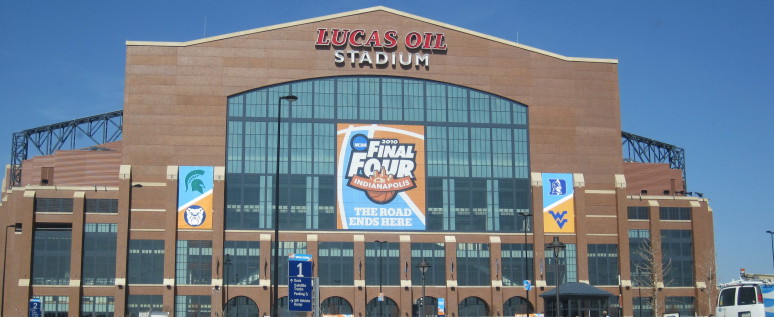The NCAA Men’s Basketball Tournament is one of the most exciting events in sports. That is why there are more than 70 million brackets that get filled out.
That pales in comparison to the estimated $2.5 billion bet on the games. It is one of the busiest times for college basketball betting and fans alike.
You might refer to it as March Madness or the Big Dance as so many others do. Even if you look forward to the Tournament each year, have you stopped to think about its history?
This article takes a step back and shows you how March Madness has evolved into what it is today and maybe helps you find an angle or two to help predict who will win the NCAA tournament this year.
Since the first NCAA Tournament in 1939, we have seen the field expand to 68 teams.
It’s also safe to say that no other event has conjured up more friendly wagering in the form of bracket pools.
March Madness: Men’s NCAA College Basketball Tournament History
Number of Teams in the Field
From 1939-1950 the college basketball tournament consisted of just 8 teams.
The field doubled over the next two years and would feature 22-25 teams from 1953-1974.
It became more standardized in 1975 when the number was set at 32. That only lasted 3 seasons before it was increased to 40 teams in 1979. Just one year later, the field jumped to 48 teams.
The field expanded to 64 teams in 1985. That lasted until 2001 when we added a play-in game to make it 65.
The bracket grew to 68 in 2011, as we added three more play-in games.
Think the play-in game is a new thing? The tournament actually held four play-in games in 1983 and five in 1984.
As of right now, there are 32 automatic invites given to the conference champions. The committee then selects 36 at-large teams to fill the rest of the field.
Incredible Underdog Wins
There have been several big upsets throughout the years.
There have been two #14 seeds advanced to the Sweet 16. Cleveland St did it first in 1986 and Chattanooga followed suit in 1977.
In 2002, #12 seed Missouri made an incredible run to the Elite 8.
LSU advanced to the Final 4 in 1986 as a #11 seed. A feat that has since been duplicated by George Mason (2006) and VCU (2011).
Four #8 seeds have advanced to the title game. UCLA in 1980, Villanova in 1985, Butler in 2011, and Kentucky in 2014. Those are the lowest in history. Of the four only Villanova managed to win it all.
In 2014, the national championship game saw #7 seed Connecticut defeat #8 seed Kentucky.
That is the highest total for two teams (combined seeds) since the field moved to 64 teams in 1985.
We are still waiting on the biggest Cinderella story to unfold, as we have yet to see a #16 seed defeat a #1 seed.
If you want more information on the seeds check out how far each seed has gone and the winning percentages by seed.
Strongest Dynasty
There have also been some incredible college basketball dynasties formed by NCAA tournament success.
None bigger than the UCLA Bruins. UCLA won 10 titles in 12 seasons from 1964 to 1975, including 7 in a row during one stretch. They went undefeated a record 4 times during this run.
List of Past Final Four Teams, Winners & Championship Game Scores
Most Final Four Appearances (Teams with Five or More)
| App. | Team |
|---|---|
| 20 | North Carolina |
| 17 | Kentucky, UCLA |
| 16 | Duke |
| 15 | Kansas |
| 10 | Michigan St, Ohio St |
| 8 | Indiana, Louisville |
| 8 | Indiana |
| 6 | Arkansas, Cincinnati, Oklahoma St, Syracuse, Michigan |
| 5 | Connecticut, Florida, Georgetown, Houston, Illinois, Oklahoma, Villanova |
Championship Game History
| Year | Champion (Record) | Score | Runner-Up |
|---|---|---|---|
| 2020 | No Tournament (Covid-19) | N/A | N/A |
| 2019 | Virginia (35-3) | 85-77 | Texas Tech |
| 2018 | Villanova (36-4) | 79-62 | Michigan |
| 2017 | North Carolina (33-7) | 71-65 | Gonzaga |
| 2016 | Villanova (35-5) | 77-74 | North Carolina |
| 2015 | Duke (35-4) | 68-63 | Wisconsin |
| 2014 | Connecticut (32-8) | 60-54 | Kentucky |
| 2013 | Louisville (35-5) | 82-76 | Michigan |
| 2012 | Kentucky (38-2) | 67-59 | Kansas |
| 2011 | Connecticut (32-9) | 53-41 | Butler |
| 2010 | Duke (35-5) | 61-59 | Butler |
| 2009 | North Carolina (34-4) | 89-72 | Michigan St |
| 2008 | Kansas (37-3) | 75-68 (OT) | Memphis |
| 2007 | Florida (35-5) | 84-75 | Ohio State |
| 2006 | Florida (33-6) | 73-57 | UCLA |
| 2005 | North Carolina (33-4) | 75-70 | Illinois |
| 2004 | Connecticut (33-6) | 82-73 | Georgia Tech |
| 2003 | Syracuse (30-5) | 81-78 | Kansas |
| 2002 | Maryland (32-4) | 64-52 | Indiana |
| 2001 | Duke (35-4) | 82-72 | Arizona |
| 2000 | Michigan State (32-7) | 89-76 | Florida |
| 1999 | Connecticut (34-2) | 77-74 | Duke |
| 1998 | Kentucky (35-4) | 78-69 | Utah |
| 1997 | Arizona (25-9) | 84-79 (OT) | Kentucky |
| 1996 | Kentucky (34-2) | 76-67 | Syracuse |
| 1995 | UCLA (31-2) | 89-78 | Arkansas |
| 1994 | Arkansas (31-3) | 76-72 | Duke |
| 1993 | North Carolina (34-4) | 77-71 | Michigan |
| 1992 | Duke (34-2) | 71-51 | Michigan |
| 1991 | Duke (32-7) | 72-65 | Kansas |
| 1990 | UNLV (35-5) | 103-73 | Duke |
| 1989 | Michigan (30-7) | 80-79 (OT) | Seton Hall |
| 1988 | Kansas (27-11) | 83-79 | Oklahoma |
| 1987 | Indiana (30-4) | 74-73 | Syracuse |
| 1986 | Louisville (32-7) | 72-69 | Duke |
| 1985 | Villanova (25-10) | 66-64 | Georgetown |
| 1984 | Georgetown (34-3) | 84-75 | Houston |
| 1983 | North Carolina State (26-10) | 54-52 | Houston |
| 1982 | North Carolina (32-2) | 63-62 | Georgetown |
| 1981 | Indiana (26-9) | 63-50 | North Carolina |
| 1980 | Louisville (33-3) | 59-54 | UCLA |
| 1979 | Michigan State (26-6) | 75-64 | Indiana St |
| 1978 | Kentucky (30-2) | 94-88 | Duke |
| 1977 | Marquette (25-7) | 67-59 | North Carolina |
| 1976 | Indiana (32-0) | 86-68 | Michigan |
| 1975 | UCLA (28-3) | 92-85 | Kentucky |
| 1974 | North Carolina State (30-1) | 76-64 | Marquette |
| 1973 | UCLA (30-0) | 87-66 | Memphis St |
| 1972 | UCLA (30-0) | 81-76 | Florida St |
| 1971 | UCLA (29-1) | 68-62 | Villanova |
| 1970 | UCLA (28-2) | 80-69 | Jacksonville |
| 1969 | UCLA (29-1) | 92-72 | Purdue |
| 1968 | UCLA (29-1) | 78-55 | North Carolina |
| 1967 | UCLA (30-0) | 79-64 | Dayton |
| 1966 | UTEP (28-1) | 72-65 | Kentucky |
| 1965 | UCLA (28-2) | 91-80 | Michigan |
| 1964 | UCLA (30-0) | 98-83 | Duke |
| 1963 | Loyola (Ill.) (29-2) | 60-58 (OT) | Cincinnati |
| 1962 | Cincinnati (29-2) | 71-59 | Ohio St |
| 1961 | Cincinnati (27-3) | 70-65 (OT) | Ohio St |
| 1960 | Ohio State (25-3) | 75-55 | California |
| 1959 | California (25-4) | 71-70 | West Virginia |
| 1958 | Kentucky (23-6) | 84-72 | Seattle |
| 1957 | North Carolina (32-0) | 54-53 (3OT) | Kansas |
| 1956 | San Francisco (29-0) | 83-71 | Iowa |
| 1955 | San Francisco (28-1) | 77-63 | LaSalle |
| 1954 | La Salle (26-4) | 92-76 | Bradley |
| 1953 | Indiana (23-3) | 69-68 | Kansas |
| 1952 | Kansas (28-3) | 80-63 | St. John’s |
| 1951 | Kentucky (32-2) | 68-58 | Kansas St |
| 1950 | CCNY (24-5) | 71-68 | Bradley |
| 1949 | Kentucky (32-2) | 46-36 | Oklahoma A&M |
| 1948 | Kentucky (36-3) | 58-42 | Baylor |
| 1947 | Holy Cross (27-3) | 58-47 | Oklahoma |
| 1946 | Oklahoma State (31-2) | 43-40 | North Carolina |
| 1945 | Oklahoma State (27-4) | 49-45 | NYU |
| 1944 | Utah (21-4) | 42-40 (OT) | Dartmouth |
| 1943 | Wyoming (31-2) | 46-34 | Georgetown |
| 1942 | Stanford (28-4) | 53-38 | Dartmouth |
| 1941 | Wisconsin (20-3) | 39-34 | Washington St |
| 1940 | Indiana (20-3) | 60-42 | Kansas |
| 1939 | Oregon (29-5) | 46-33 | Ohio St |
Other Related Articles on Tournament History


